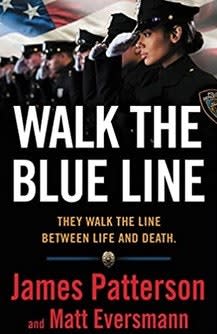Earlier this year massively successful fiction author James Patterson published a non-fiction book on what it’s like to be a law enforcement officer in contemporary America.
Editorial: Thoughts on “Walk the Blue Line”
The best-selling book from James Patterson and Matt Eversmann is a collection of narratives from individual cops telling stories of what it’s like to wear a badge in contemporary America.

“Walk the Blue Line” by Patterson and Matt Eversmann blasted into the best-seller lists like any other book bearing Patterson’s golden byline. The remarkable thing is that it is still a hot title, which we can either attribute to the public’s interest in gaining insight into the law enforcement profession or to Patterson’s popularity. Or more likely both.
The following is not so much a review of the book but just my thoughts on its content and execution.
In promos for the book, Patterson promises that it is not “pro-cop or anti-cop; it’s just cop.” That’s true. Although I would say it leans pretty strongly toward pro cop. Actually, it’s leaning pro individual cop.
“Walk the Blue Line” tells the stories of individual officers, one officer at a time. Most of the stories are told under the officer’s names but without identifying their agencies. This is something we do often at POLICE for working officers who are willing to speak but don’t want to run afoul of their brass. We’ll write something like “Sgt. Joe Smith is a patrol supervisor with a major Midwestern police department” for example.
The book tells the stories of these officers in short narratives, and it is structured in three sections: Protect, Serve, and Defend. Why certain narrative are assigned to these sections was unclear to me during a quick read. Maybe I could draw a clearer connection between the stories and the themes with a deeper read.
But “Walk the Blue Line” is not a book that invites a deeper read. It’s meant for quick consumption. It’s a book of vignettes that draws no conclusions about the state of policing in America and makes few judgments. Which is it’s intent.
And quick reads can have value. The stories of these officers don’t probe deeply into their experience, but the stories are haunting nonetheless.
During a joint interview with Patterson on Fox News, Eversmann, an Army veteran, said he spent a year interviewing officers for “Walk the Blue Line.” Patterson’s role in production of the book is not specified in any interview or promotional material I can find, but from comments during the Fox interview, I conclude that he was involved in directing the project and probably some light editing. On Fox he emphasized that all the stories in the book are true.
They’re true and for the most part gritty. You won’t find a lot of lighthearted cop humor in them. “Walk the Blue Line” is heartbreaking and at times gruesome. Most of the experiences of these officers are the kind of stuff that can give birth to post-traumatic stress disorder. And indeed some of the officers telling the stories are suffering from PTSD. They also discuss how they are coping with the condition.
Although there is a chilling story from a probably retired officer about encountering serial killer John Wayne Gacy right before the monster was arrested in 1978, most of the book focuses on currently serving officers and contemporary situations. Many are veterans who served in the Iraq and Afghanistan wars. Some are municipal officers, some are deputies, and some are federal agents. Male and female officers and officers from a wide variety of racial and ethnic backgrounds are featured.
Topics covered in “Walk the Blue Line” run the gamut of police assignments and duties, including domestic violence response, traffic stops, fugitive apprehension, warrant service, K-9 handling, SWAT standoffs, investigations, and command, just to name a few.
You will likely identify with and empathize with the stories of these officers. For civilians, the stories may open some eyes.
There’s the NYPD officer who told Eversmann, “All my years on the job, I can count on one hand the number of homes I have entered that are filled with love.” There’s the officer who almost shot a teenager at a traffic stop because the boy kept reaching into his waistband, trying to conceal a “bag of weed.” There’s the officer who wanted to pummel a domestic abuser after the man dismissed his girlfriend’s facial injuries by saying she fell. “It’s the first time I truly understood the expression ‘seeing red,’” he told the authors. There are officers who felt the brunt of anti-police sentiment from George Floyd’s in-custody death. “A good 95 percent of the people I have been dealing with over these past few weeks have been openly hostile, and it’s exhausting.” And there’s the tale of one officer who found himself “on trial” for brutality while testifying against a perp in court.
Some of the stories featured are tales of police courage. For example, there’s Jennifer Fulford, the Florida deputy who killed two home invaders in a desperate gunfight to protect three children and save her own life. She was shot multiple times in the 2004 battle, including a wound that disabled her primary arm and forced her to defend herself one-handed shooting with her offhand. Fulford received numerous honors for her courage. She was also featured in a POLICE Magazine “Shots Fired” article that ran in the December 2005.
Perhaps the most memorable stories in “Walk the Blue Line” are those of the emotional toll of the job. One in particular is going to stick with any reader of this book; it’s the story of Laura McCord and how she had to respond to a domestic murder where a 12-year-old boy saw his mother shot by his stepfather. She’s the one who had to tell this child his mom was dead. “Tears are rolling down his face, but he doesn’t make a sound,” she told the authors.
“Walk the Blue Line” is not meant to be a deep study of law enforcement. It’s a quick read about the work and the lives of law enforcement officers and some of the stories those officers tell will stay with you. As law enforcement officers, you probably all have similar experiences. But perhaps this book will help some civilian readers realize what you go through.
For trying to get that message across, I thank James Patterson and Matt Eversmann. They have created a good read with a good purpose.
More Patrol

Top 10 POLICE Videos of 2025
What were the top videos published by POLICE in 2025? Many covered tactics and officer safety, while others came from booth visits at IACP in Denver, Colorado. In case you missed these, here are the top 10 videos.
Read More →
Flock Safety and Coreforce Partner to Enhance Real-Time Awareness and Operational Efficiency for Law Enforcement
A new integration partnership will enable Flock Safety hotlist alerts and license plate recognition (LPR) searches directly in Coreforce’s Real-Time Crime Center (RTCC) and Digital Evidence Management System (DEMS) platform.
Read More →
Ballistic Armor Co. Secures Strategic Investment to Expand U.S. Production Capabilities
Ballistic Armor Co. secured a new commitment that will accelerate its multi-year transition from a third-party tactical equipment retailer to a premium innovator and U.S. manufacturer of advanced protective systems.
Read More →
Police & Fire Championships Expands Athlete Eligibility
The US Police & Fire Championships is now open to all employees – sworn, civilian, administrative, technical, and support staff – who work directly for an eligible public safety agency.
Read More →
Tips for Watching the Hands
How can officers better “watch the hands”? Mike Willis, Law Enforcement National Training and Program Director for the US Deputy Sheriff's Association, shares some tips.
Read More →
10 Tips for Felony/High-Risk Stops
What steps can officers take to stay safer during felony or high-risk vehicle stops? Here are 10 tips from Mike Willis, Law Enforcement National Training and Program Director for the US Deputy Sheriff's Association.
Read More →
Amped Highlights Power Behind Amped FIVE Software
Amped FIVE empowers you to advance your investigations with confidence and precision, from the crime scene all the way to the courtroom.
Read More →
Police K-9 Killed, Suspect Dies in Shootout with Cops
A Burbank Police Department K-9 was fatally shot over the weekend by a passenger who fled on foot from a traffic stop. The armed suspect was killed in a shootout with officers.
Read More →
From the Show Floor: InVeris
In this video, learn about how InVeris provides training to law enforcement, including customized augmented reality scenarios. The augmented reality system can scan up to 10,000 square feet of real-life environments and create a curriculum based on those spaces.
Read More →
From the Show Floor: Polaris Government & Defense
Learn about Polaris Government & Defense in this video as POLICE visits their show booth to discover their side-by-sides and the advantages they provide for agencies.
Read More →

